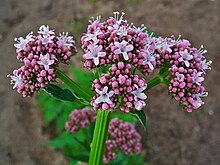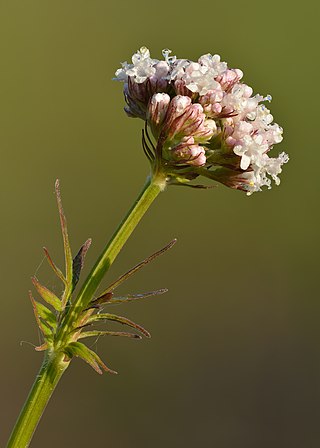
Valerian is a perennial flowering plant native to Europe and Asia. In the summer when the mature plant may have a height of 1.5 metres, it bears sweetly scented pink or white flowers that attract many fly species, especially hoverflies of the genus Eristalis. It is consumed as food by the larvae of some Lepidoptera species, including the grey pug.
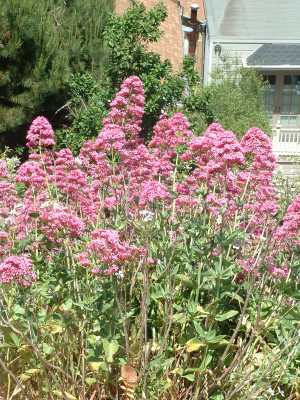
The Valerianaceae Batsch, the valerian family, was a family of flowering plants that is now considered part of the Caprifoliaceae. Plants are generally herbaceous, and their foliage often has a strong, disagreeable odor. They are found native in most regions of the world except for Australia. Some species are cultivated as ornamentals or used in herbal medicine for inducing relaxation and sleep.

Stachys is a genus of plants, one of the largest in the mint family Lamiaceae. Estimates of the number of species vary from about 300, to about 450. Stachys is in the subfamily Lamioideae and its type species is Stachys sylvatica. The precise extent of the genus and its relationship to other genera in the subfamily are poorly known.

Verbena, also known as vervain or verveine, is a genus in the family Verbenaceae. It contains about 150 species of annual and perennial herbaceous or semi-woody flowering plants. The majority of the species are native to the Americas and Asia; however, Verbena officinalis, the common vervain or common verbena, is the type species and native to Europe.

Valeriana rubra, the red valerian, spur valerian, kiss-me-quick, fox's brush, devil's beard or Jupiter's beard, is a popular garden plant grown for its ornamental flowers.

Staphylea, called bladdernuts, is a small genus of 10 or 11 species of flowering plants in the family Staphyleaceae, native to temperate regions of the Northern Hemisphere. The highest species diversity is in China, where four species occur.

Cleome is a genus of flowering plants in the family Cleomaceae, commonly known as spider flowers, spider plants, spider weeds, or bee plants. Previously, it had been placed in the family Capparaceae, until DNA studies found the Cleomaceae genera to be more closely related to the Brassicaceae than the Capparaceae. Cleome and clammyweed can sometimes be confused.

Valeriana amazonum is a species of plant in the family Caprifoliaceae. It is endemic to Italy.

Valeriana nuttallii, or Nuttall's cornsalad, is a small dicot annual plant of the family Caprifoliaceae which can be found growing within the United States in areas of Oklahoma and Arkansas.

Valeriana congesta, synonym Plectritis congesta, is a species of flowering plant in the honeysuckle family. It is known by several common names, including shortspur seablush and rosy plectritis. It is native to western North America.

Valeriana ciliosa is a species of flowering plant in the honeysuckle family known by the common name longspur seablush. It is native to western North America from Washington to Baja California and Arizona, where it is a common plant in mountains, valleys, and coastal habitats.

Valeriana macrocera is a species of flowering plant in the honeysuckle family known by the common names longhorn seablush and white plectritis. It is native to western North America from British Columbia to Montana to California, where it is a common plant in mountains, valleys, open steppe, and coastal habitat types. It is an annual herb growing erect to a maximum height between 60 and 80 centimeters. The widely spaced, paired and oppositely arranged leaves are oval or somewhat oblong, smooth-edged, and up to 4.5 centimeters long by 2 wide. The upper ones lack petioles. The inflorescence is a dense, cylindrical, headlike cluster of flowers in shades of pale pink to white. The corolla is under a centimeter long and is divided into five lobes and a short, blunt spur.

Valeriana jatamansi, formerly known as Valeriana wallichii, is a rhizome herb of the genus Valeriana and the family Valerianaceae also called Indian Valerian or Tagar-Ganthoda, not to be confused with ganthoda, the root of Indian long pepper. It is an herb useful in Ayurvedic medicine used as an analeptic, antispasmodic, carminative, sedative, stimulant, stomachic, and nervine.

Urceolina is a genus of South American plants in the amaryllis family native to Bolivia, Brazil, Colombia, Costa Rica, Ecuador, Guatemala, Panama, and Peru. It has also been introduced to many South and Central American states, as well as India and Sri Lanka. The formerly accepted genera Eucharis and Caliphruria are now regarded as synonyms of this genus. Many species of this genus share the common name Amazon lily.

Valeriana macrosiphon, also commonly called long-spurred valerian, is a herb of the family Caprifoliaceae.
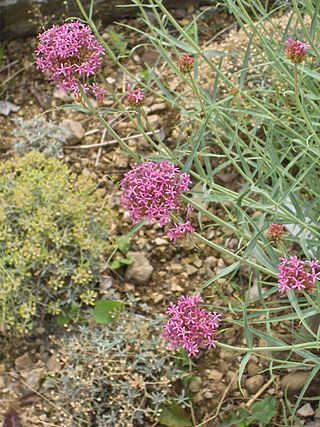
Valerianoideae is a subfamily of plants.
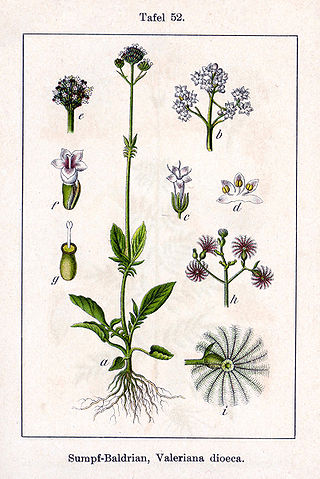
Valeriana dioica, the marsh valerian, is a species of flowering plant in the family Caprifoliaceae, native to North America, Europe and Anatolia. It is typically found in calcareous fens. It is a dioecious species, with male and female flowers on separate individuals, and it is pollinated by small flies.

Valeriana eriocarpa is a species of flowering plant in the family Caprifoliaceae. It is an annual native to western and southern Europe, northwestern Turkey, and north Africa.
